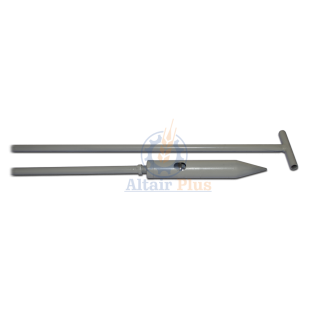Altair Plus Company provides warranty and after-warranty service and repair of products manufactured by the company. Warranty periods are indicated in the accompanying documentation and may vary depending on the type of product.
Payment is carried out according to the invoice issued by prior agreement with the manager of the company. You can pay an account at any bank or transfer money through another bank account.
Delivery across Ukraine of the goods ordered by you can be carried out by the cargo-transport companies “Delivery”, “SAT”, “Novaya Pochta”, “Night Express”. Delivery is carried out within 1-3x working days in the most appropriate way for a particular order at the expense of the buyer.
Structurally, the barn probe is a long rod with a container for collecting grain at one end and a handle at the other.
Key elements:
- Grain intake.
- Collapsible bar.
- Cross handle.
- Collapsible bar.
- Cross handle.
Grain intake design includes: container, tip and valve.
The cylindrical container of the intake serves as a direct container for taking a grain sample, by filling it through the hole (s) in the upper part of its body. A conical point with a smooth surface facilitates immersion of equipment to the required depth due to the spreading of grains. The valve protects the container from ingress of grain when the equipment moves into the depth of the embankment, and ensures that the grains enter the container when it is removed, which determines the possibility of taking a sample from a certain depth (immersion).
The collapsible rod is intended for delivering an empty grain container to a predetermined depth, opening the valve and then removing the intake with its contents (grain) from the tested batch of products. The collapsible joint in the middle of the bar provides folding equipment for easy carrying, storage and transportation.
The transverse handle, which is firmly fixed to the middle at an angle of 90° at the end of the rod, makes it easy to remove the barn probe from the grain after opening the valve and filling the intake.
You can buy a barn probe in Altair Plus PE using the contact information and the feedback form on the Contact page.
Technical characteristics of the barn probe:
| Volume of product to be taken, cm3 | 165 |
| Dimensions (probe length x probe tip x handle), mm | 2820х40х240 |
| Weight, kg | 4,6 |
Rules and order of operation
Most often, the product is stored disassembled, so it must be assembled before use. It is also recommended that you first make sure that the valve opens and closes freely by moving it by hand in both directions along the axis of the rod.
Operating procedure:
Most often, the product is stored disassembled, so it must be assembled before use. It is also recommended that you first make sure that the valve opens and closes freely by moving it by hand in both directions along the axis of the rod.
Operating procedure:
1 - Immerse the grain probe to the desired depth (when immersed, the intake valve should automatically close with the counter pressure exerted by the product particles).
2 - Open the intake valve with a short probe upward movement and wait a bit for the grain to fill the container.
3 - Remove the dipstick from the grain.
?4 - Pour the contents of the intake into a container for storing grain samples.
2 - Open the intake valve with a short probe upward movement and wait a bit for the grain to fill the container.
3 - Remove the dipstick from the grain.
?4 - Pour the contents of the intake into a container for storing grain samples.
Try to avoid backward jerks of the handle and rod when diving, to avoid premature opening of the intake openings and getting into the sample container of grain from the surface layers (not studied at the moment).
The remaining measurements are carried out similarly. After completion of work, the equipment must be thoroughly cleaned of sample residues, after which it can be collected for storage.

























